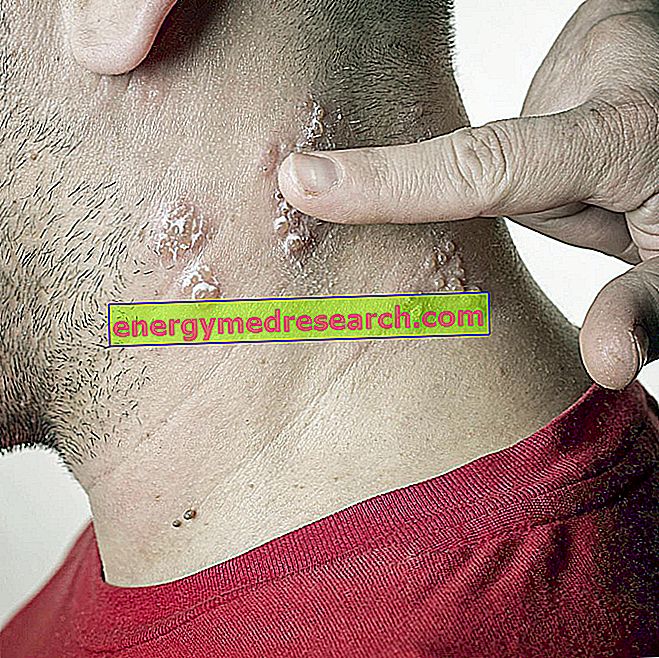Generality
One speaks of tachycardia - from the Greek tachys (rapid or accelerated) and kardia (of the heart) - when the resting heart rate exceeds the upper limits of normality for the reference population. In the adult, for example, there is tachycardia whenever the heart rate (HR) at rest exceeds 100 beats per minute (bpm).
| Tachycardia heart rates in the various periods of life | |
| Age | FC (bpm) |
| 1-2 days 3-6 days 1-3 weeks 1-2 months 3-5 months 6-11 months 1-2 years 3-4 years 5-7 years 8-11 years 12-15 > 15 years | > 159 > 166 > 182 > 179 > 186 > 169 > 151 > 137 > 133 > 130 > 119 > 100 |
The speed with which the cardiac cycle takes place is regulated by electrical impulses finely distributed to the various regions of the myocardium; if for some reason there are problems at the level of the "control units" and the "electrical networks" of the heart, the heart rate can rise (tachycardia) or fall (bradycardia) excessively. While the latter condition, especially in young people and sportsmen, is often devoid of pathological significance, tachycardia - although sometimes separated from any health problem - is more often a sign of pathological conditions. Excessive resting heart rate can indeed disturb the normal functions of the heart, raising the risk of suffering a stroke or sudden cardiac arrest.
Symptoms and complications
A heart that beats too quickly - losing its natural harmony in alternating contractions and relaxation - can compromise the normal blood supply to the various districts of the body. The consequent suffering of the most poorly perfused tissues is the basis of the symptoms typically associated with tachycardia: dyspnea, palpitations (annoying perception of the heartbeat), syncope (fainting), chest pain and vertigo. In some people, however, tachycardia is completely asymptomatic and as such is occasionally diagnosed during routine assessments.

Causes
Any drug, condition or disease that can interfere with the normal electrical activity of the heart may be responsible for tachycardia.
Did you know that ...
During fever states, the pulse rate increases by about 8 bpm for each temperature above 37 ° C, while the metabolism rises by 13%.
This is the case, for example, of smoking, alcoholism, excessive consumption of coffee or other nerve foods, abuse of recreational drugs (such as cocaine or amphetamines), electrolytic alterations, excessive stress or anxiety, of hyperthyroidism / thyrotoxicosis, of hypertension, of fever, of anemia, of congenital malformations of the heart or of its damage by particular diseases (for example due to a previous heart attack). Iatrogenic tachycardias can be registered in predisposed subjects who take drugs such as asthmatics and antihistamines.
In physiological conditions tachycardia arises after intense physical activity and following strong emotions; it may happen, for example, that it is the same anxiety triggered by the medical examination that significantly increases the resting heart rate.
Electrical activity of the heart and associated disorders
In the heart, inside the right atrium, we find the so-called "sinus node" (or sino-atrial node), a natural pacemaker from which electrical stimuli are discharged at a regular rate of 60/100 beats per minute. These signals are transmitted to the muscle tissue of the atria, triggering atrial contraction and the subsequent passage of blood into the ventricles.
The electrical impulses originating from the atrial sinus node arrive up to a group of specialized cells, which together form the so-called atrioventricular node, a sort of relay that transmits the electrical signal to another group of cells, called His bundle, which in turn it leads the impulse from the atrioventricular node to the two ventricles. When the electrical stimulus reaches them, they contract, pumping blood into the pulmonary circulation (right ventricle) and into the systemic one (left ventricle).

In the event that an anomaly occurs in one of the various components of the electrical system of the heart, more or less severe arrhythmias may appear, associated or not with tachycardia. In relation to the characteristics of the anomaly and of the electrocardiographic tracing, specific medical terms are used, such as: sinus tachycardia (the most common form), ventricular tachycardia, supraventricular tachycardias, atrial fibrillation, ventricular fibrillation and atrial flutter.
Diagnosis
The most important diagnostic tool is the electrocardiogram, which uses small electrical sensors, connected to the chest and arms, to record the electrical impulses of the heart and their conduction. The exam can be conducted at rest, under stress and in other stress conditions, or for extended periods of time using portable devices.
Special blood tests may be necessary to investigate the presence of underlying diseases.
Treatment
See also: Tachycardia medications
Certain forms of tachycardia do not require any treatment, while in other cases it is necessary to intervene pharmacologically. There is also the possibility of performing maneuvers capable of lowering the heart rate; among these we remember the forced expiration with closed glottis (Valsalva maneuver), the application on the face of cold water or an ice bag, the unilateral massage or compression of the carotid and bilateral of the eyeballs; all, of course, according to the advice of your doctor, since these interventions can be very dangerous for some categories of patients. If all this is not successful, especially in the most serious episodes, it is necessary to inject antiarrhythmic drugs, able to re-establish the normal heart rate. In even more severe cases, with obvious danger of death, medical aid can intervene with electroconversion (using the "famous" defibrillator seen in many cinematic scenes).
To prevent the recurrence of tachycardia and its complications, beta-blockers (propranolol and esmolol) and calcium channel blockers (diltiazem and erapamil) can be given. At other times the patient must undergo cardiac ablation operations, in which small, particularly flexible, lead leads are inserted into the blood vessels and made to reach the heart. Once localized, the area of tissue that determines the electrical problem is destroyed using radio frequencies.
In certain circumstances it is necessary to implant cardioverter-defibrillators, small electrical devices capable of picking up tacho-arrhythmias in the bud and producing responses that can restore normal heart rate.



